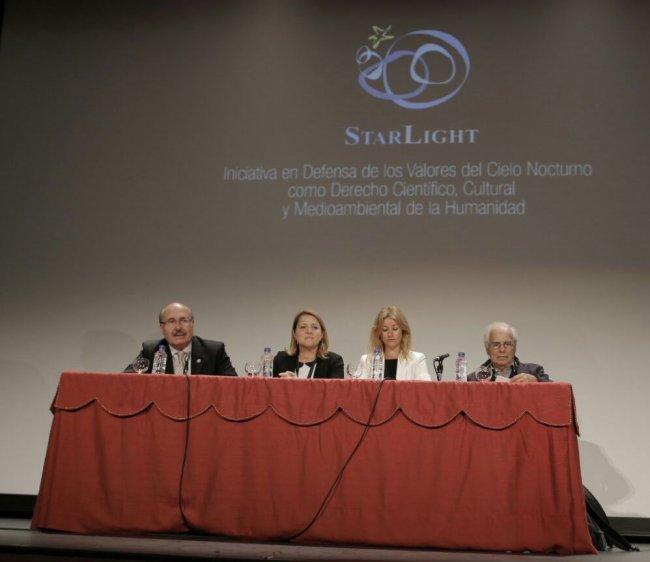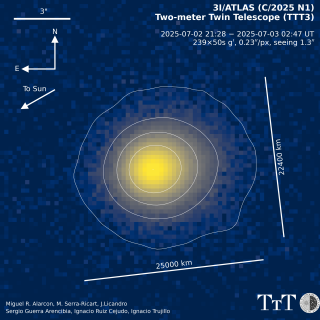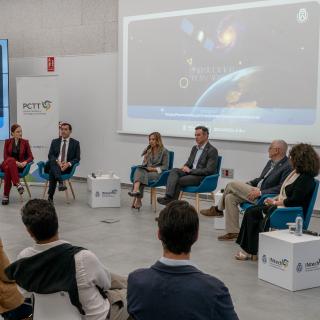This morning saw the start, in the Circo de Marte Theatre of Santa Cruz de La Palma, of the multidisciplinary international conference "Preserving the Skies", which celebrates the 10th anniversary of the Starlight Declaratin of La Palma for the protection of dark skies, and which is graced by the Presidency of Honour of His Majesty King Felipe VI. During today, and until Friday 21st April professionals from different areas will debate, in the capital of La Palma, how to protect and conserve the sky from different perspectives.
The first session of the conference was preceded by words of welcome from the local authorities and the organizers. Alicia Vanoostende, councillor for tourism, representing the President of the Cabildo of La Palma reminded us that as well as this conference we are celebrating the 10th anniversary of the Starlight Declaration of La Palma, with many parallel activities, both cultural and for leisure, in the whole Island, including blackouts of street lighting by all the municipalities of La Palma. The city councillor of Santa Cruz de La Palma for Culture and Tourism, Virginia Espinosa, respresenting the Mayor expressed her wish that the conference "will be an inspiration for the start of activities to protect the sky" and that "all over the world people are following the example of La Palma", the host city, which "has a great deal to offer both in the sky and on the ground". Representing the Starlight Foundation Francisco Sanchez, the Founding Director of the Instituto de Astrofísica de Canarias (IAC) reminded us that the Declaration was "a world-wide initiative which aimed to stimulate, and keeps stimulating people to preseve the sky and enjoy it both for science and as human beings", and that now we have sites whose skies are well studied, and protected and have received certificates to prove this. Rafael Rebolo, the Director of the IAC added "We need dark skies which are of use not only to scientists, but also to society in general. This is very positive socially and economically for society, which this conference will serve to demonstrate".
Landscape and sky
The lecture which opened the meeting was dedicated to the preservation of the cultural values of Starlight. The IAC researcher and expert in Archeoastronomy Juan Antonio Belmonte explained the relation between landscape and sky since the dawn of humanity, as well as the intitiative Astronomy and World Heritage supported by UNESCO and the IAU (International Astronomical Union) to highlight the value of those sites where human society has given shape to its fascination for celestial phenomena, as well as bringing out the benefits to the economy and to identity which stem from the protection of the night sky. An example of this is the creation by Division C of the IAU "Education, Outreach and Heritage" of Commission C4 "World Heritage and Astronomy". UNESCO will consider sites of astronomical interest to be declared World Heritage sites. Juan Antonio Belmonte explained that certain sites had been promoted in this context, among them the Jaipur Observatory, in India, and the Domens of Antequera in Spain, and that more such promotions can be expected in the future. Finally he pointed out the challenges faced when aiming to declare other sites of astronomical interest as World Heritage sites.
Malcolm Smith, an astronomer at the Cerro Tololo Interamerican Observatory (CTIO) in Chile continued with the historical narrative, and explained a study which he had carried out for the World Heritage Committee of UNESCO in 2010 in which is included the project "Windows to the Universe". This project is aimed at obtaining recognition and protection for the main advanced observatories in the world, in the Canaries, the North of Chile, and Hawaii.
Chris Smith, director in Chile of the US organization AURA (Association of Universities for Research in Astronomy) talked about the preservation of dark skies. He commented that it had been necessary to re-think the original idea of the project "Windows to the Universe", looking for local support and organizing new strategies in order to make the intiative more successful. "Being declared a World Heritage Site" he warned, "will not contribute, in the short term, to control the risks for astronomical observation" at least in Chile so that he recommended "in the short term we must strengthen local activities directed at solving, one by one, the problems associated with light pollution, and in the long term strengthen initiatives which increase the evaluation and the identification of Chilean society with the observatories and their work. "If this finally leads to the Declaration of a site as a World Heritage, this would be a success, but this is not the main aim, at least in Chile. He also stressed that education and outreach are essential for a good strategy.
Economic return
María Rosa Cárdenas, from the Secretariat of the UNESCO programme MAB (Man and the Biosphere) expalined that this programme promotes international action for the defence of dark skies. The majority of the Biosphere Reserves, which are in Europe, include this defence, because light plays a key role in biodiversity. "For example" she explained "birds use the moon to guide their flight by night and if they pass through an area with strong outdoor lighting they lose their way". This entails the need to promote sustainable economic activity, such as the tourist boom in Iceland associated with the observation of the the aurora borealis, and to promote outreach to the local population so that they become involved in intiatives to protect the night sky. "We need a reform of the energy sector and the use of intelligent street lighting" she added, giving the information that where suitable studies had been carried out, for every euro invested in improving the illumination they are earning 1.9 euros, almost double the investment, due to the increase of astronomical tourism which this generates. She stated that the Starlight initiative is a complement to the worldwide network of Biosphere Reserves, because it protects biodiversity, the economy, and green society, improves education, and leads towards sustainable development.
Cultures of Central America
The meeting continued with José Franco, a researcher at the Instituto de Astronomia of the UNAM (National Autonomous University of Mexico) and coordinator of the Consultative Scientific and Technological Forum of Mexico, who talked about the role of dark skies in pre-hispanic cultures. He began by mentioning the Stonehenge site in the United Kingdom as well as the different routes of the Camino de Santiago, which represented the Milky Way, and then moved on to the cosmic visions in central America "where certain buildings were used to observe cosmic events". He pointed up the importance of the sky for the Mayas and he focused on emblematic sites such as the Temple of Kukulkan in Chichen Itzá, where we can see the shadow of a serpent which apparently moves down the stairs of the pyramid during the equinoxes, and he mentioned the description of some of the constellations, shown in the Mayan glipts. He added that the images on the Codex of Paris show representations of the Milky Way, and of constellations such as the Tortoise, the Rattlesnake, the Bird, and the Jaguar. "a compete celestial zoo" which has yet to be identified. It is curious that the Scorpion may in fact correspond to our own constellation of the same name.
Juan Antonio González of "Cielos de La Palma" (Skies of La Palma) considered himself to be "a son of the first Starlight meeting in 2007" where he and other local amateur astronomers gave a talk entitle "La Palma and its 14 skies, stressing the astronomical potential of the Island. In that context they visited all 14 municipalities of the Island to take photographs of the night sky, with which they put on an exhibition of photographs and a film. Since then, Gonzalez has taken several initiative, and has set up the first private company for astronomical tourism on La Palma. "I am", he says, "a living example of how an amateur interest can become a paid profession, and now, thanks to an interdisciplinary group of people (guides, astronomers, historians, cooks....), he is carrying out many and varied activities which include holidays in astronomically oriented rural houses, the creation of astronomical lookout points, gastronomy with astronomical themes (g-astronomical restaurants), and wines with stellar themes ("Vega Norte"), astronomical cruises, interactive games, and merchandising. Finally he presented the video "La Palma, living with the Universe" with spectacular images of the skies over the Island.
Leopoldo Luis Martín Rodríguez, of the Galileo Galilei Foundation, and an expert in fotonic devices presented an open programming code based on Arduino ( a low cost microcomputer which is easy to reconfigure) for use in monitoring the sky, with visible and infrared sensors. He explained as a point of interest that he was introducing Arduino programming in the schools in La Palma.
Stefano Cavazzani, of the University of Padua, analysed a study of the light emissions in the Canaries between 1991 and 2013 from satellite measurements. In principle one can observe fluctuations in the most urbanized zones of Gran Canaria and Tenerife due to meteorological conditions. However in the islands there has been a major increas in light pollution in the outskirts of the cities. In La Palma there have also been variations in Los Llanos de Aridane and Santa Cruz de La Palma, but these are neglibible compared to what has been seen in other places, which means that on this island " they have done a good job.
Benefits in terms of identity
The morning sessions finished with a talk by Gabriel Rodríguez, director of the Department of Energy, Science and Technology, and Innovation of the Ministry of External Affairs of Chile, who centred his discussion on the policies of his government for the protection of a dark and quiet sky. " It is a key aspect " he explained " because in Chile there are 50% of the astronomical installations in the world, which will soon rise to 70%. Astronomy is an opportunity for technology above all for big data. We should not understand astronomy only as science, but also for the technology that goes with it". He went on to say that " Astronomy is also important for education because it helps to understand the logic of scientific thought. The sky is a natural resource, and as such we must protect it. It implies a challenge and a responsibility. The sky surrounds a community, its contemplation combines and coordinates different initiatives and encourages people to work together. That is why the Starlight initiative is so important. We need specific laws to protect observatories, and their skies. There are also benefits in terms of identity and economic gains due to the rise in local productivity associated with astrotourism. The protection of the sky and the observatories is a cultural and political problem, not a technical one".



